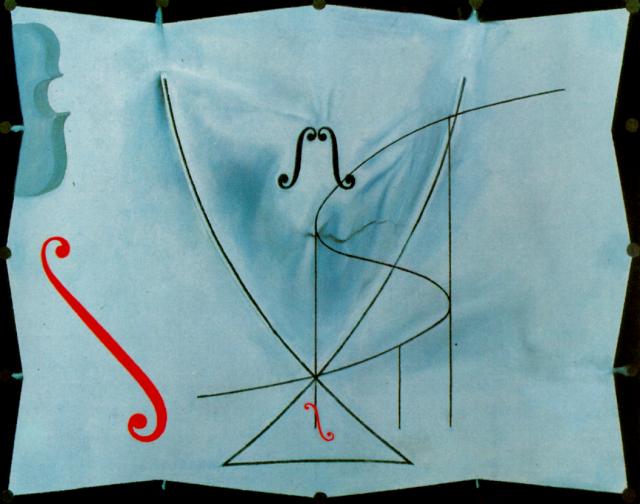- The Swallow's Tail
backcolor=#FBF5DF
painting_alignment=right
image_size=300px
title=The Swallow's Tail — Series on Catastrophes
artist=Salvador Dalí
year=1983
type=Oil on canvas
height=73
width=92.2
height_inch=28.74
width_inch =36.30
diameter_cm =
diameter_inch =
city=Figueres
museum=Dalí Theatre and Museum "The Swallow's Tail — Series on Catastrophes" (French: "La queue d'aronde — Série des catastrophes") was the last painting of
Salvador Dalí , done in May 1983. It is the final work in a series based onRené Thom 'scatastrophe theory .Thom suggested that in four-dimensional phenomena, there are seven possible equilibrium surfaces and therefore seven possible discontinuities, or "elementary catastrophes": fold, cusp, swallowtail, butterfly, hyperbolic umbilic, elliptic umbilic, and parabolic umbilic. [Thom, René, Structural stability and morphogenesis. an outline of a general theory of models, (D.H.Fowler, trans.) (Reading, Mass. London. Benjamin. 1975). Originally published in French as Stabilité structurelle et morphogénèse, 1972.] "The shape of Dalí’s Swallow’s Tail is taken directly from Thom’s 4-dimensional graph of the same title, combined with a second catastrophe graph, the s-curve that Thom dubbed, "the cusp". Thom’s model is presented alongside the elegant curves of a
cello and the instrument’s f-holes, which, especially as they lack the small pointed side-cuts of a traditional f-hole, equally connote the mathematical symbol for an integral incalculus : int_{}^{} ." [King, Elliott in Dawn Ades (ed.), Dalí (Milan: Bompiani Arte, 2004), 418-421.]In his 1979 speech, "Gala, Velázquez and the Golden Fleece", presented upon his 1979 induction into the prestigious Académie des Beaux-Arts of the Institut de France,
Dalí described Thom’s theory of catastrophes as ‘the most beautiful aesthetic theory in the world’. [Dalí, Salvador, ‘Gala, Velásquez and the Golden Fleece’ (9 May 1979). Reproduced in-part in Robert Descharnes, Dalí, the Work, the Man (New York: Harry N. Abrams, 1984) 420. Originally published in French as Dalí, l'oeuvre et l'homme (Lausanne: Edita, 1984).] He also recollected his first and only meeting with René Thom, at which Thom purportedly told Dalí that he was studying tectonic plates; this provoked Dalí to question Thom about the railway station atPerpignan , France, which the artist had declared in the 1960s as the centre of the universe. Thom reportedly replied, "I can assure you that Spain pivoted precisely — not in the area of — but exactly there where the Railway Station inPerpignan stands today". Dalí was immediately enraptured by Thom’s statement, influencing his painting Topological Abduction of Europe — Homage to René Thom, the lower left corner of which features Thom’s equation for the ‘swallow’s tail’, V = x^5 + ax^3 + bx^2 + cx, an illustration of the graph, and the term ‘queue d'aronde’. The seismic fracture that transverses Topological Abduction of Europe reappears in The Swallow’s Tail at the precise point where the y-axis of the swallow’s tail graph intersects with the S-curve of the cusp. [King, E., 418-421.]References
Wikimedia Foundation. 2010.

